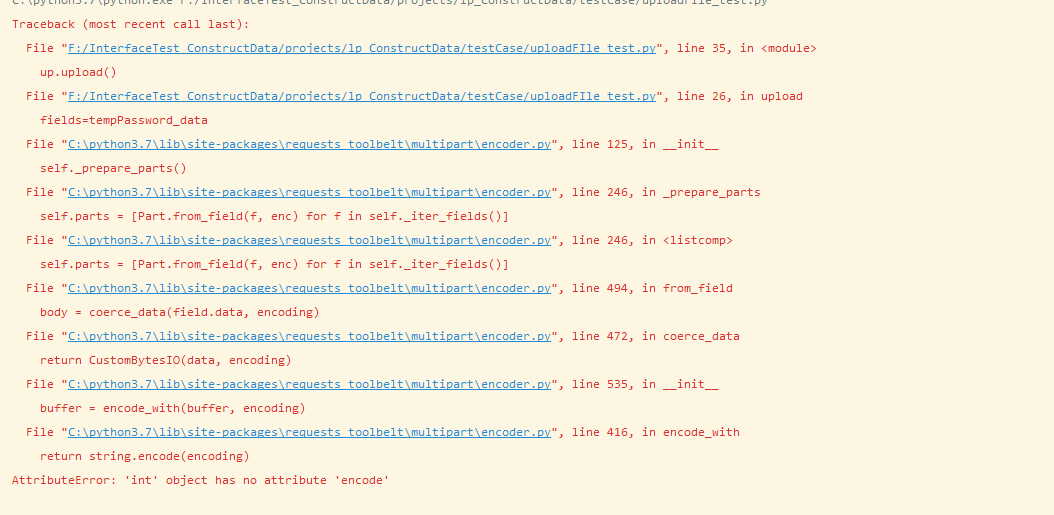Python基于requests實(shí)現(xiàn)模擬上傳文件
方法1:
1.安裝requests_toolbelt依賴庫
#代碼實(shí)現(xiàn)def upload(self): login_token = self.token.loadTokenList() for token in login_token: tempPassword_url = self.config[’crm_test_api’]+’/document/upload’ tempPassword_data = self.data_to_str.strToDict(’’’title:1.png course_name_id:63 course_id:1112 desc:7 doc_type:1 is_public:1’’’,value_type=’str’) files={’file’: (’1.png’, open(’C:UsersAcerPicturesScreenshots1.png’, ’rb’), ’image/png’)} tempPassword_data.update(files) m = MultipartEncoder(fields=tempPassword_data ) tempPassword_headers = {'Content-Type': m.content_type, 'token': token} tempPassword_request = requests.post(url=tempPassword_url,data=m,headers=tempPassword_headers) print(tempPassword_request.content)
2.組裝MultipartEncoder對象需要的參數(shù):將tempPassword_data的字段合并至files
1.files參數(shù)介紹:
1.字典key對應(yīng)file字段(我們系統(tǒng)是這樣,具體結(jié)合前端實(shí)際的字段為準(zhǔn)),如圖

2.字典value里面的對象:
1.filename(服務(wù)器最終存儲(chǔ)的文件名)
2.filepath(具體的文件路徑,注意轉(zhuǎn)義),文件是以二進(jìn)制的形式進(jìn)行傳輸?shù)模赃@里傳輸時(shí)以二進(jìn)制的形式打開文件并傳輸
3.content_type:具體結(jié)合前端實(shí)際的字段為準(zhǔn):一般可定義為: 文本(text)/圖片(image)等[/code][code]
3.tempPassword_data:為文件上傳時(shí)的附帶參數(shù)
strToDict方法:自己手寫的一個(gè)字符串轉(zhuǎn)dict的方法
遇到的問題:

這個(gè)錯(cuò)誤是說,int對象不能被編碼,所以需要手動(dòng)將int對象轉(zhuǎn)換為str,所以我在此方法中定義了value_type這個(gè)參數(shù),用于將字典中的所有value轉(zhuǎn)換為str類型
#具體代碼實(shí)現(xiàn),僅供參考def strToDict(str_in,value_type=None): # value_type:轉(zhuǎn)換字典的value為指定的類型,未防止異常,目前僅支持str # ’’’將str轉(zhuǎn)換為dict輸出’’’ # ’’’將帶有time關(guān)鍵字的參數(shù)放到字符串末尾’’’ # print(str_in) if str_in: match_str = ’:’ split_str = ’n’ split_list = str_in.split(split_str) str_in_dict = {} for i in split_list:colon_str_index = i.find(match_str)if colon_str_index == -1: # ’’’處理firefox復(fù)制出來的參數(shù)’’’ match_str = ’t’ or ’ ’ colon_str_index = i.find(match_str)# ’’’去掉key、value的空格,key中的引號’’’str_in_key = i[:colon_str_index].strip()str_in_key = str_in_key.replace(’'’,’’)str_in_key = str_in_key.replace('’',’’)# 正則過濾無用key,只保留key第一位為字母數(shù)據(jù)獲取[]_str_sign = re.search(’[^a-zA-Z0-9_[]+]’, str_in_key[0])if str_sign is None: # 處理value中的空格與轉(zhuǎn)義符 str_in_value = i[colon_str_index + 1:].strip() str_in_value=str_in_value.replace(’’,’’) try: # 遇到是object類型的數(shù)據(jù)轉(zhuǎn)換一下 str_in_value=eval(str_in_value) except BaseException as error: str_in_value=str_in_value if value_type in [’str’,’string’]: str_in_value=str(str_in_value) else: str_in_value=str_in_value str_in_dict[str_in_key] = str_in_value return str_in_dict else: print('參數(shù)都沒有,還處理個(gè)球嘛') return None
3.請求時(shí)將headers的content設(shè)置為m.content_type,會(huì)設(shè)置headers的content_type為form—data,類型為str:
MultipartEncoder相關(guān)源碼:


4.請求時(shí)設(shè)置data為m,會(huì)輸出一個(gè)MultipartEncoder對象:

方法2:
直接使用requests,無需依賴requests_toolbelt庫
過程大同小異,也是需要將字典的value轉(zhuǎn)換為str
注意:headers不要傳content_type字段,headers不要傳content_type字段,headers不要傳content_type字段
請求時(shí):data對應(yīng)附加參數(shù),files對應(yīng)files對象
#相關(guān)代碼def upload(self): login_token = self.token.loadTokenList() for token in login_token: tempPassword_url = self.config[’crm_test_api’]+’/document/upload’ tempPassword_data = self.data_to_str.strToDict(’’’title:1.png course_name_id:63 course_id:1112 desc:7 doc_type:1 is_public:1’’’,value_type=’str’) files={’file’: (’1.png’, open(’C:UsersAcerPicturesScreenshots1.png’, ’rb’), ’image/png’)} tempPassword_headers = {'token': token} tempPassword_request = requests.post(url=tempPassword_url,data=tempPassword_data,files=files,headers=tempPassword_headers) print(tempPassword_request.json())
以上就是本文的全部內(nèi)容,希望對大家的學(xué)習(xí)有所幫助,也希望大家多多支持好吧啦網(wǎng)。
相關(guān)文章:
1. Java類加載機(jī)制實(shí)現(xiàn)步驟解析2. JAMon(Java Application Monitor)備忘記3. IntelliJ IDEA設(shè)置背景圖片的方法步驟4. Python OpenCV去除字母后面的雜線操作5. Spring security 自定義過濾器實(shí)現(xiàn)Json參數(shù)傳遞并兼容表單參數(shù)(實(shí)例代碼)6. docker /var/lib/docker/aufs/mnt 目錄清理方法7. Python os庫常用操作代碼匯總8. Python TestSuite生成測試報(bào)告過程解析9. IntelliJ IDEA設(shè)置默認(rèn)瀏覽器的方法10. 增大python字體的方法步驟

 網(wǎng)公網(wǎng)安備
網(wǎng)公網(wǎng)安備